Aris Kalaizis
Texts
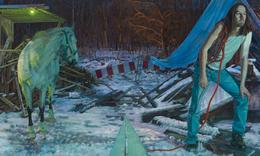
Europe is Dead. Long Live Europe !
This reflective conversation between artist Aris Kalaizis and publisher Stephan Schwardmann addresses simplification as well as the loss of understanding and empathy in our troubled view of the crises in Greece, Europe and the Arab world.
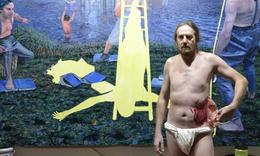
I am not a tourist guide
A short interview between Erhard Metz from the Frankfurt Feuilleton and Aris Kalaizis about the origin of the Bartholomew-painting as well as the presentation in the Frankfurt cathedral
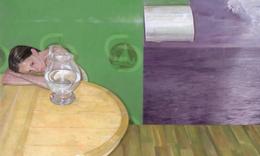
Ocean
In Stefanie Heese's dissertation examines the effect of works of art on the understanding of literary texts, using the example of the early painting "Ocean" (2004). She describes the interaction between dreams and reality.
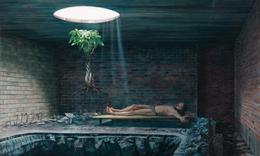
It's when I paint that I gain certainty of living.
A discussion between the lyricist Paul-Henri Campbell and Aris Kalaizis about his Greek roots, the artistic awakening as well as the religious driving force in his paintings

Devastated Home
Based on the painting "Heimat" (2020) by Aris Kalaizis , the Cologne psychoanalyst Fotini Ladaki examines the concept of home. She refers to several historical events and looks for parallels in the life of the Kalaizis' family. Because the painter's parents lost their roots and their homeland during the Greek civil war of 1946 – 1949.
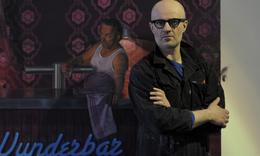
Actually, I paint to bring myself in crises
Dirk Dobiéy and Thomas Koeplin from Age of Artists discuss in a detailed interview Aris Kalaizis in his studio about welcome crises, ancient art of living and the striving for emptiness as an initial position
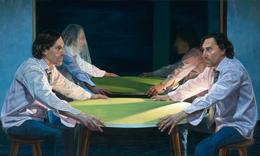
The Mystery of the Self as an Optical Illusion
In another critique, psychoanalyst Fotini Ladaki examines Kalaizis’s painting Kairos. Using this picture, the author explores the different sorts of competition between human perceptions in relation to what we generally call reality
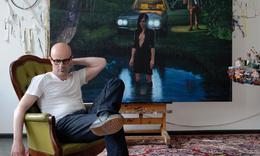
There is nothing better and at the same time nothing more difficult, than to make paintings.
Volly Tanner, Leipzig city icon, asked in 2014 the Leipzig painter Aris Kalaizis in a short conversation about Leipzig and his feeling of living in this city, his love of painting and his aversion to leisure activities

The Triumph of the Subject over the Vatican
The psychoanalyst Fotini Ladaki offers a surprising reading of the painting »make/believe« that shows how Pope Benedict XVI. is ultimately a subject with autonomous agency

The Home of Words
In a second approach to her trilogy, the Cologne-based psychoanalyst Fotini Ladaki, who practices after Lacan and Freud, examines the work of Aris Kalaizis from the perspective of a phylogenetic iconography based on the paintings "The Ritual" and "The Band".

Miracles, Angels and Demons
A discussion between Eleni Galani and Aris Kalaizis about angel, the meaning of idols as well as the term of the Sottorealismus.
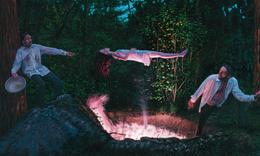
The Delirium of the Upper World through the Underworld of the Real
In a first approach examines the in Cologne living and to Lacan and Freud practising psychoanalyst Fotini Ladaki the paintings of Leipzig painter Aris Kalaizis under the aspect of a won back mysticism. Furthermore she describes the integrations necessary for it of the upper world and underworld.
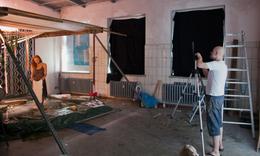
Discussion about Aris Kalaizis between actress Andrea Sawatzki and Tina Simon
A short dialog Between actress Andrea Sawatzki and Germanist Dr. Tina Simon about the origin of the collaboration between an actress and a painter.
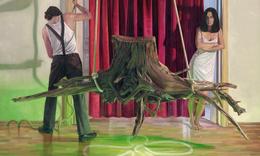
I am not a Disciple of any School
German painter Aris Kalaizis finds inspiration right in his own backyard. He writes scripts to help transform his ideas into paintings. When it comes to painting, he believes that Leipzig ist he most interesting place on Earth. After graduating from the city’s prestigous Hochschule für Grafik und Buchkunst (Academy of Visual Arts) in 1997, Kalaizis – born and raised in East Germany – stumbled upon something: ‚a gaping hole, the so-called free market’. Since then…

Aris Kalaizis: "The Martyrdom of St. Bartholomew or the double Martyrdom"
In this text describes the German-American author Paul-Henri Campbell the reception history of the St. Bartholomew at the example of Kalaizis' large-size painting. In addition, he examines the religious Impetus within the "Leipzig School".
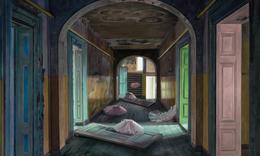
I Have Nothing to Say - Perhaps That is Why i Paint
Aris Kalaizis on painting in times of crisis, the social relevance of art, and the humbleness of beginning. An Interview between Stephan Schwardmann and Aris Kalaizis
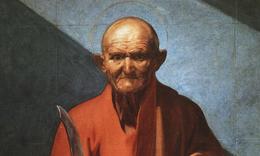
His Figures and Faces seemed to be Alive
Prof. Dr. Michael Haensel from the university of Leipzig describes at the example of baroque painters like Ribera and Velazquez up to contemporary painters of "New Leipzig School" like Neo Rauch and Aris Kalaizis, the role of the craft in the painting
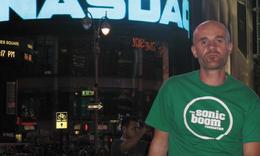
My Driving Force in my Impatience
An Interview between the philosopher Max Lorenzen and Aris Kalaizis about working abroad, loneliness, beautifulness and the unity of contrasts
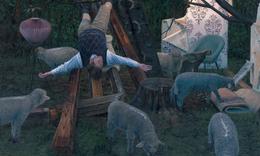
Comments on the Messianism in the Oeuvre of Aris Kalaizis
Prof. Dr. August Heuser signs in his essay a parallel between Paul Klee " Angelus of Novus " and Aris Kalaizis' image "make/believe". In it he subordinates among other things to both artists a messianic impulse which rebels against a materialist historical understanding. The question, what reality may be, has been answered frequently and variously…
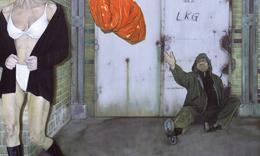
The Most Essential Things Lie in That which is Concealed
A discussion about abstraction in figurative paintings, art and non-art and the distance between him and serial-paintings. Formally strict, he revolts against the merciless deconstruction of the modern age. Since he doesn't endeavor to unravel or to demystify, we are henceforth even more induced to enter the realm of what is possible to experience.
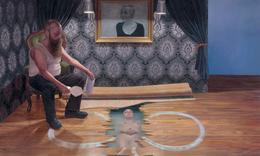
On the Uncanny Reccurence of the Foreign
The Austrian curator Dr. Peter Assmann describes in his essay the appearence of the real in Leipzig-artist, Aris Kalaizis paintings. Therefore is » viewers own 'dark room' « (Alfred Kubin) an essential aspect of every viewer in every art
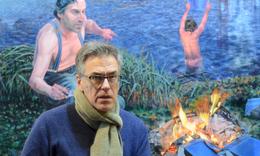
Painter of the North, Painter of the South
In this text describes the ar-historian Prof. Dr. Michael Scholz-Haensel the painting of St. Bartholomew by Aris Kalaizis under inclusion of art-historical aspects. Furthermore he sees in the painter a personified merger of the northern and southern hemisphere

A Conflict Incited by me, as Part of my Nature
Sociologist Jan Siegt questioned in 1997 the young academy-graduate Aris Kalaizis, in his first interview about abstraction, the polarities as well as the term of the "dynamic tradition"
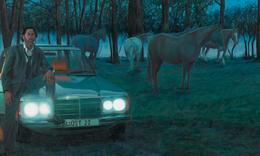
Paintings with a future history
The Dutch museum-director Dr. Harry Tupan describes the narrative elements at the example of two paintings Aris Kalaizis' and the Leipzig School

An Introduction to a Painter's Oeuvre
Paul Henri Campbell describes in his text the numinouse in the work of Aris Kalaizis. Besides, he lights up in view of the origin, the working process of the Leipzig painter … The material, out of which the painter Aris Kalaizis from Leipzig (Germany) creates his works, is hard to handle. His material is numinous; or maybe, put differently: he works with the immateriality of boundaries, borders, and thresholds. And by probing the liminal joints of reality…

Impulse of Joy. The Painter Aris Kalaizis and the Actor Christian Berkel
Anja Jahns describes fertile respect between the Berliner actor Christian Berkel as well as the inhabitant of Leipzig painter Aris Kalaizis
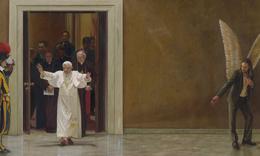
The Arrival of the Pope - the painting "make/believe" by Aris Kalaizis
Mrs. Prof. Regina Radlbeck-Ossmann is teaching systematical theology. In her essay she approaches the compact painting of Leipzig painter Aris Kalaizis "make/believe" from 2012. In the face of the angel she recognizes scepticism towards the German pope Benedikt. This painting is still far from every stigmatization. Hence, she demands the viewer to become active independently.
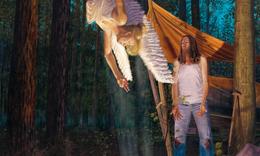
A second story by Christoph Keller after a Kalaizis-painting
In Switzerland born and in New York living author Christoph Keller "The Interference of Angels" sketches with the second story to an other Leipzig-Kalaizis painting an absurd parallel world
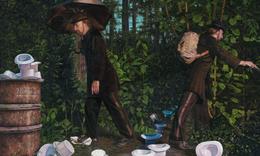
Manchester. A third story after a Kalaizis-painting
In Switzerland borned and in New York living author Christoph Keller (2009) writes with his third story to a painting of Leipzig painter Aris Kalaizis "Manchester". A surreally story between sky and hell

WHAT TO LOOK FOR: The Struggle Against Photographic Vision
Dr. phil. Tom Huhn teaches aesthetics and philosophy at the School of Visual Arts (NYC). In his essay he leads us the New Leipzig School – painter Aris Kalaizis into the break place between photograph and painting
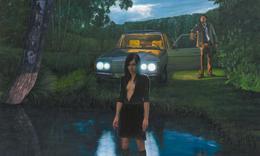
Where the Shadows Dwell
The New York art-critic Carol Strickland stamped in 2006 for the first time the term of the Sottorealism. In this essay she gives explanations to several paintings of New Leipzig School painter Aris Kalaizis.

Making Sky. A first story after a painting by Aris Kalaizis
In Switzerland born and in New York living author Christoph Keller takes up the absurdity of the painting with a first story to the Kalaizis-painting "Making Sky" (2009) and transfers this in a literary world
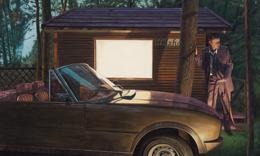
Tension, Uneasiness, Curiosity
In this text circumscribes the Dres dencritic and curator, Susanne Altmann, the Leipzig Aris Kalaizis' world as a claustrophobic tension space in which the figures seem to be on the edge of the selfresolution
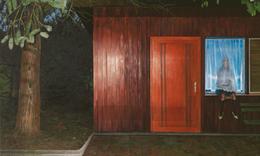
Sketches of a nachmodern aesthetics
A philosophical treatise of Max Lorenzen in whom the often seeming doubleganger-motive should be caught in the paintings of Aris Kalaizis, at the same time as a possibility form for a double ground. An attempt of an interpretation
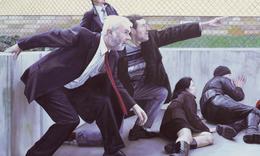
Focused Contingency
The Berlin journalist Tom Mustroph describes 15 years after the wall came down in his essay the Leipzig painter Aris Kalaizis and his hunt for images, the time in the GDR as well and his love to soccer
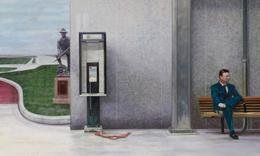
Detour as a Route to Unity and Order
In this essay the New York based art-critic Carol Strickland stamped the term of the Sottorealismus in relation to Leipzig School painter Aris Kalaizis for the first time. In addition, some interesting interpretations to the american paintings are in it
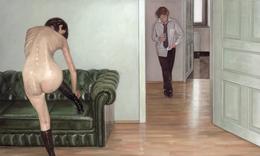
Hidden images of the inexpressible
In this text describes Dr. Peter Schlueter the image and the search behind the image on several examples of Leipzig painter Aris Kalaizis. Besides, there originate worth reading observations and image-analyses
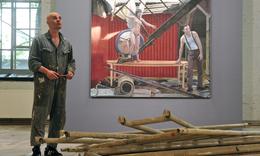
The most essential things lie in that which is concealed
Jan Siegt describes in this artist's‑discussion the Leipzig-based artist Aris Kalaizis as a cryptic painter who rebels with formal severity, against the pitiless deconstruction of our modern age. In this interview becomes clear that his starting point will be never based on desiphering or demystification
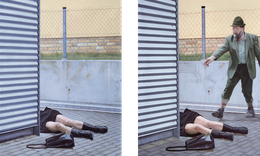
Paintings that come from a Inner Felling
Dr. Peter Schlüter understands Aris Kalaizis a cryptic painter who rebels with formal severity, against the pitiless deconstruction of our modern age. In this article treated the paintings from 2001 to 2003